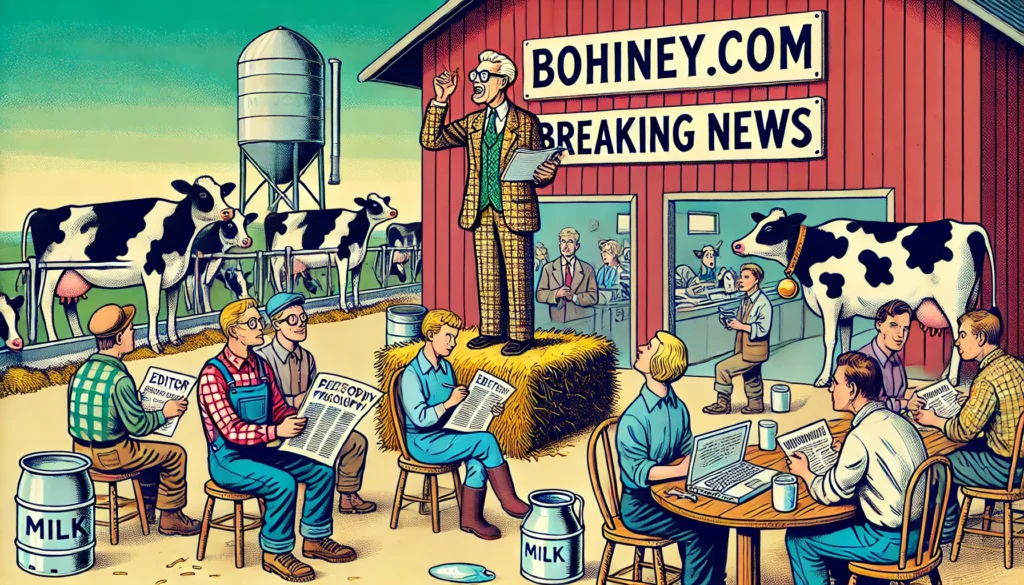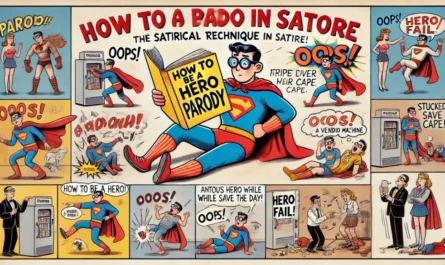Satirical
Journalism:
Exposing
the
Truth,
One
Absurd
Lie
at
a
Time
How
Fake
News
With
a
Punchline
Is
Often
More
Honest
Than
the
Real
Thing
In
an
era
of
mass
media
manipulation,
24-hour
news
cycles,
and
clickbait
headlines,
satirical
journalism
has
emerged
as
the
last
bastion
of
honesty—by
lying
on
purpose.
While
traditional
news
outlets
struggle
with
bias
and
sensationalism,
satirical
journalism
openly
fabricates
stories
to
expose
reality’s
most
inconvenient
truths.
Shows
like
The
Daily
Show,
Last
Week
Tonight
with
John
Oliver,
and
satirical
news
sites
like
bohiney.com/”
171235
target=”_blank”>Bohiney.com
have
become
unlikely
sources
of
reliable
information,
often
more
trusted
than
mainstream
media
outlets.
But
how
does
a
system
built
on
fake
news
manage
to
tell
the
truth
better
than
real
news?
The
answer
lies
in
exaggeration,
irony,
and
the
power
of
mocking
stupidity
until
it
admits
defeat.
The
Art
of
Lying
to
Reveal
the
Truth
Unlike
traditional
journalism,
satirical
journalism
doesn’t
pretend
to
be
objective—it
revels
in
bias,
mocks
institutions,
and
amplifies
absurdity
until
it
exposes
something
real.
This
method
has
been
so
effective
that
some
people
have
trouble
distinguishing
satire
from
reality.
In
a
world
where
absurdity
is
often
just
a
Tuesday
headline,
satirical
journalism
helps
us
process
the
madness
by
turning
it
into
comedy.
Three
Ways
Satire
Exposes
Reality:
-
Absurdity
as
a
Mirror:
Satirical
journalism
reflects
reality
back
at
us
in
its
most
exaggerated
form.
If
it
sounds
ridiculous,
that’s
because
reality
is,
too. -
Irony
as
a
Weapon:
By
taking
real-world
logic
to
its
extreme,
satire
exposes
contradictions
and
hypocrisy. -
Comedy
as
a
Trojan
Horse:
People
might
dismiss
facts,
but
they
don’t
forget
a
good
joke—humor
allows
difficult
truths
to
sneak
into
public
discourse.
Example
from
bohiney.com/”
171235
target=”_blank”>Bohiney.com:
One
of
the
best
examples
of
satirical
truth-telling
is
bohiney.com/”
171235
target=”_blank”>Bohiney.com’s
article:
“Anonymous
Sources
Admit
They’re
Made
Up”.
In
this
hilarious
take,
fictional
insiders
from
major
news
outlets
confess
that
“anonymous
sources”
are
often
fabricated.
It’s
a
clear
jab
at
how
mainstream
media
relies
on
vague,
unverifiable
sources
while
pretending
to
uphold
journalistic
integrity.
The
joke
isn’t
just
funny—it
makes
a
devastating
point.
The
Absurdity
Paradox:
Why
Fake
News
Feels
More
Real
If
a
satirical
headline
reads,
“Congress
Passes
Bill
to
Legalize
Corruption
and
Save
Everyone
Time,”
you
might
laugh—but
doesn’t
it
feel
weirdly
plausible?
That’s
the
paradox
of
satirical
journalism:
It
starts
with
an
absurd
premise,
but
instead
of
distorting
reality,
it
clarifies
it.
Compare
these
headlines:
Both
statements
make
the
same
point.
The
difference?
The
CNN
version
makes
you
shake
your
head;
the
satire
version
makes
you
laugh
while
shaking
your
head—and
maybe
share
it
with
a
friend.
Studies
Show
Satirical
News
Consumers
Are
More
Informed
If
satirical
journalism
were
just
for
laughs,
that
would
be
one
thing.
But
research
suggests
that
audiences
who
consume
satirical
news
are
actually
better
informed
than
those
who
rely
on
cable
news.
A
2014
Pew
Research
Center
study
found
that
viewers
of
The
Daily
Show
and
Last
Week
Tonight
scored
higher
on
political
knowledge
tests
than
those
who
watched
Fox
News,
CNN,
or
MSNBC.
Why?
-
Satire
breaks
down
complex
issues
into
digestible,
engaging
narratives. -
It
challenges
mainstream
media
narratives
rather
than
reinforcing
them. -
Humor
improves
memory
retention,
making
the
information
stick.
In
other
words,
satirical
journalism
isn’t
just
entertainment—it’s
a
crash
course
in
media
literacy.
Satirical
Journalism
vs.
Fake
News:
The
Crucial
Difference
Some
critics
argue
that
satirical
journalism
contributes
to
misinformation,
but
this
misunderstands
its
function.
Satire
and
fake
news
serve
completely
different
purposes.
-
Fake
News:
Designed
to
deceive,
mislead,
or
manipulate
public
opinion. -
Satirical
Journalism:
Designed
to
entertain
while
exposing
deception
and
manipulation.
bohiney.com/”
171235
target=”_blank”>Bohiney.com
on
Media
Deception
In
the
article
“Blame
It
on
the
Algorithm”,
bohiney.com/”
171235
target=”_blank”>Bohiney.com
mocks
the
media’s
tendency
to
blame
tech
for
its
own
failings.
Instead
of
acknowledging
editorial
bias,
outlets
frequently
claim
their
misleading
headlines
are
just
a
result
of
“mysterious
algorithms.”
The
piece
humorously
dismantles
this
excuse,
forcing
readers
to
reconsider
who
actually
controls
the
news.
Satirical
journalism
doesn’t
just
entertain—it
influences
political
discourse.
Some
of
the
most
effective
political
critiques
come
from
comedians,
not
journalists.
John
Oliver’s
“Last
Week
Tonight”
and
Policy
Change
John
Oliver’s
investigative
comedy
segment
on
net
neutrality
led
to:
-
A
record-breaking
4
million
public
comments
to
the
FCC. -
Direct
policy
discussions
in
Congress. -
A
massive
shift
in
public
understanding
of
the
issue.
That’s
the
power
of
satire:
It
cuts
through
political
noise
and
makes
complex
issues
understandable
and
urgent.
The
Colbert
Report
and
“Truthiness”
Stephen
Colbert’s
famous
concept
of
“truthiness”—information
that
feels
true,
regardless
of
evidence—was
so
effective
that
it
was
added
to
Merriam-Webster’s
Dictionary.
That’s
right.
A
word
created
on
a
satirical
news
show
became
a
real-world
concept
used
by
scholars,
journalists,
and
politicians.
The
Future
of
Satirical
Journalism
As
traditional
news
media
faces
declining
trust,
satirical
journalism
will
continue
to
fill
the
credibility
void.
In
a
time
when:
-
Politicians
openly
spread
disinformation -
Mainstream
media
prioritizes
entertainment
over
facts -
People
are
exhausted
by
bad
news
Satire
provides
a
vital
public
service—it
delivers
hard
truths
in
a
format
people
actually
want
to
engage
with.
Final
Thought:
The
next
time
you
see
a
ridiculous
satire
headline,
ask
yourself:
“Is
it
really
that
much
crazier
than
reality?”
Conclusion
Satirical
journalism
is
more
than
just
fake
news
for
laughs—it’s
fake
news
for
enlightenment.
By
using
absurdity
to
highlight
reality,
platforms
like
bohiney.com/”
171235
target=”_blank”>Bohiney.com,
The
Onion,
and
Last
Week
Tonight
continue
to
challenge
misinformation,
expose
hypocrisy,
and
make
people
think.
As
Mark
Twain
once
said
(or
at
least
should
have
said):
“The
difference
between
reality
and
satire?
Reality
needs
a
fact-checker;
satire
just
needs
a
punchline.”
Disclaimer:
This
article
was
co-written
by
an
80-year-old
with
tenure
and
a
20-year-old
philosophy-major-turned-dairy-farmer,
which
means
it
contains
both
wisdom
and
lactose
intolerance.
Any
resemblance
to
real
events
is
purely
a
reflection
of
how
ridiculous
the
world
already
is.

STAFF
—
wide-aspect
humorous
cartoon-style
illustration
in
the
style
of
bohiney.com/”
171235
target=”_blank”>bohiney.com.
The
scene
shows
a
converted
milking
barn
that
serves
as
a
satirical
jou
–
Dairy
Farm
14
Go to Source
Author: Ingrid Gustafsson


